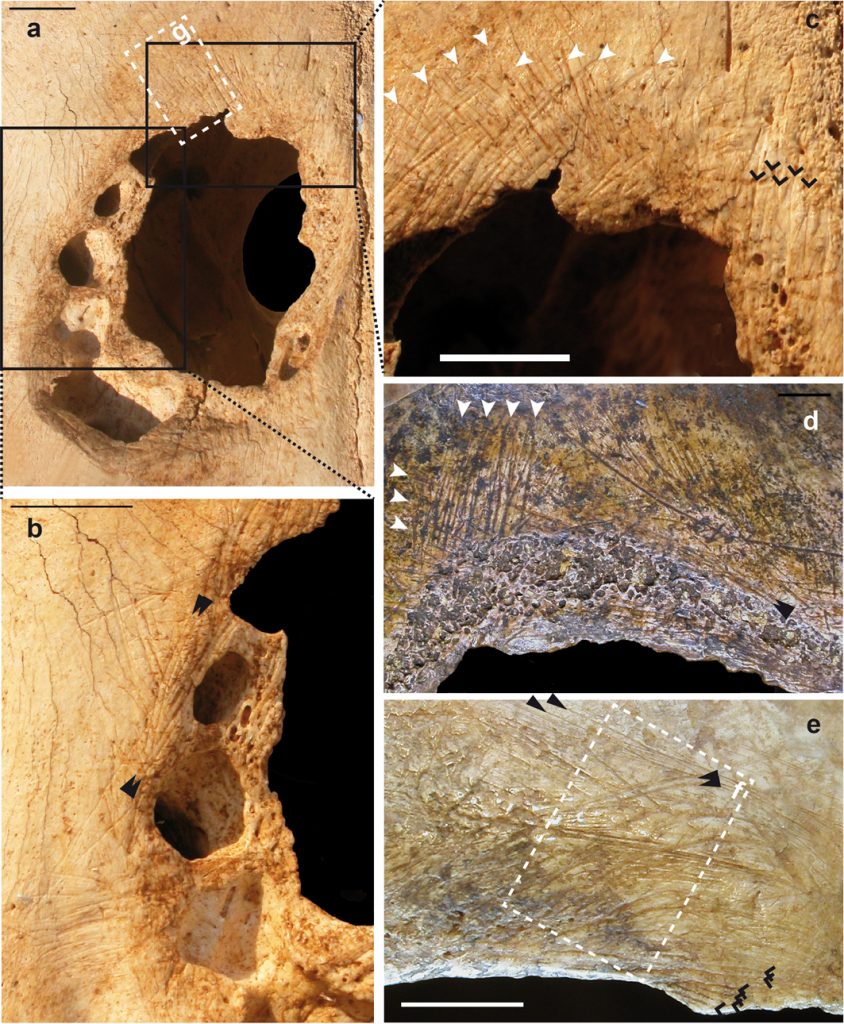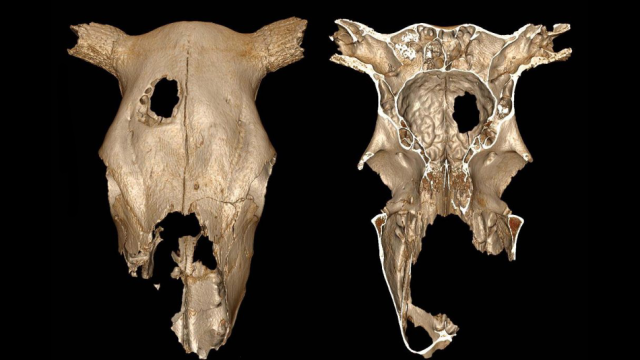Humans have been drilling holes into each others’ heads for thousands of years, and, surprisingly, we’ve actually been pretty good at it, even way back when. A re-analysis of a 5,000-year-old cow’s skull suggests humans were performing cranial surgery on animals as well – but why would they even bother? The answer could yield new insights into ancient human behaviour and the origin of practices that still exist to this very day.
Cranial surgery, or trepanation, has been performed for thousands of years among a diverse range of human cultures, with some of the oldest examples dating back 12,000 years to the Mesolithic period. Anthropologists aren’t entirely sure why they did it, but it was probably done to treat physical symptoms, sometimes as part of a spiritual ritual. That said, the reasons for the practice likely varied according to each society and the period in which it took place.
What we do know, however, is that trepanation was done with great care, and with the intent to inflict as little harm to the patient as possible. To do it, these ancient proto-brain surgeons formed a hole in the skull, either by drilling, cutting, or scraping away the layers of bone. Incredibly, the most primordial examples of trepanation seen in the archaeological record match the ones performed in more recent historic times, including the Medieval era, and with the same degree of accuracy. We’re not sure how these pioneering brain surgeons acquired their skills, but they may have experimented on dead humans, or perhaps on living or dead animals. Paleontological evidence is sorely lacking in this area, but a new study published today in Scientific Reports is finally offering some clues.
In the early 1970s, archaeologists uncovered a Neolithic site in France called Champ-Durand. Some 5,000 years ago, this area was home to a vibrant trade center, salt production, and the rearing of cattle, sheep, pigs, and goats. In 1999, an excavation at Champ-Durand yielded a nearly complete cow’s skull with a hole in it, but the archaeologists who unearthed it figured it was a puncture wound inflicted by another animal’s horn. Unconvinced, paleontologists Alain Froment and Fernando Ramirez Rozzi from the French National Center for Scientific Research (CNRS) took a new look at the ancient skull, concluding that it’s the earliest evidence of a surgical procedure performed on an animal.

Cut-marks in the cow skull (a, b, c) and a human skull (d, e) from the Neolithic era suggests the technique used for the trepanation in humans was the same used on the cow. Image: Fernando Ramirez Rozzi
Physical analysis of the hole, which measures 64.5 mm long and 46.5 mm wide, shows no trace of fracturing or splintering, which means it wasn’t caused by a powerful blow, such as goring from another cow or a puncture inflicted by a stone tool. At the same time, the hole shows the characteristic signs of trepanation, namely a square-like shape and cut marks made around the gap. No marks exist on the skull to indicate that pressure was applied by an external force. This hole, the researchers argue, was cut – quite literally – with surgical precision.
The hole exhibits no sign of healing, which means the procedure was performed on a dead cow, or the cow did not survive the surgery. The procedure may have been done to save an ill cow, the researchers surmise, but no signs of illness were detected in the skull. Even so, it wouldn’t have made sense for these Neolithic humans to attempt a medical procedure, or even some kind of ritual practice, on a ubiquitous animal that represented a common food staple. More likely, the procedure was done as practice for trepanation on humans, a finding which may explain why ancient humans were so good at this early form of brain surgery.
“It is possible that the mastery of techniques in cranial surgery shown in the Mesolithic and Neolithic periods was acquired through experimentation on animals,” write the authors in the new study. “Cranial surgery as a practice could also have been performed on live animals; the lack of healing in the cow analysed here could reveal a failure of the surgical intervention.”
While this is a distinct possibility, the authors don’t deny that trepanation may have been done to heal the cow, saying either scenario is plausible. Either way, it’s the first evidence of surgical experimentation on an animal, or the very first record of a veterinary act.
Which, wow. That’s kind of mindblowing.
Pier Paolo Petrone, an anthropologist at the University of Naples who wasn’t involved in the new study, said the conclusions made by the authors were “basically correct” given the evidence.
“Several studies prove trephination by scraping – the oldest technique adopted by surgeons – to be most successful in terms of survival rate,” Petrone told Gizmodo. “This probably reflects the fact that adoption of freshly knapped stone scrapers avoided accidental penetration of the dura mater – a thick fibrous membrane that is the outermost of the three layers of the meninges that surround the brain and spinal cord – allowing longer survival and a lower risk of infection and physical damage to the brain.”
The significance of the finding, he says, is that Neolithic surgeons, at least from this single example, preferred to experiment on animals – dead or alive, we don’t know – before operating on a human. “That ultimately remains the most interesting point of this work, being very likely to exclude other motivations such as magical-ritual or symbolic practices,” he said.
That Neolithic humans would experiment on animals makes sense. Practicing on dead humans probably seemed repugnant in light of the reverence shown in funerary rituals; many ancient humans treated their dead with deep respect. What’s more, trepanations were complicated procedures, and likely done for a host of reasons, so practice was not just a good idea – it was essential.
As Petrone explained to Gizmodo, cranial surgeries were often done to treat skull fractures and wounds, intracranial disorders (e.g. increased and decreased cerebrospinal fluid (CSF) pressure), chronic headaches, brain tumours, and other painful disorders. These pioneering surgeons were working to raise depressed fractures, remove bone fragments, smooth gashes, and possibly drain epidural hematomas to relieve intracranial pressure.
Cranial surgeries were also done as part of magic-ritual practices, but in these cases, “symbolic trepanations” involved the removal of only the external compact layer of the skull, and possibly the spongy part of the cranium, and without penetrating the endocranial space (the layer between the skull and the brain), explained Petrone.
And incredibly, many of these interventions were successful.
“The success of ancient surgical interventions is typically testified by bone regrowth around the cranial hole, the degree of bone recovery being indicative of the post-operative survival time,” said Petrone. “Healing processes of surgically treated ancient skulls show that in such times where anesthesia, asepsis, and antibiotics were still unknown, more than 50 per cent of trephinations were successful. If complications such as haemorrhaging, brain damage, wound infection, or meningitis did not occur after [cranial surgery], and if primary bone healing took place, long-term survival was often observable.”
It’s humbling to think of Neolithic humans scrambling to find solutions to treat serious head injuries or illnesses. That they actually became pretty good at it is testament to our species, and our willingness to experiment. Death, whether it be 5,000 years ago or today, is something humans rail against with every ounce of our ingenuity.
